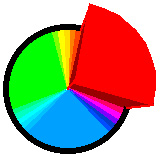

The paper clip... is a powerful force for order. --Newsweek Special Issue. Winter 1997-98
Some material sets the stage for the presentation of a course via the Internet. We will explore the larger context (strengths, weaknesses, appropriateness) and spend some time on how to be an Internet student, also known as a self-regulated learner.
Although you are accustomed to being an expert learner, there are some differences (and some similarities) in this particular environment. This section will also include how you can successfully set the context for your own students in terms of course objectives and appropriate behaviors. At a minimum, context means you must now consider the international implications of your course decisions.
I use the color red to symbolize context.
You will be introduced to a variety of technology tools for teaching/learning. Distributed learning courses can be as simple as a textbook and E-mail or telephone conversations.
Many more complex interactions are also possible. For example, we will take a field trip to a MOO or MUD (Multi-User Domain) for real-time (synchronous) conversation (also known as "chat".)
We will explore the role of visual literacy and learn publishing principles for the web. We will evaluate various options for assessment of student learning. We will explore the overriding importance of interactivity and application assignments.
I use the color blue to call your attention to skills content.
The consequences of Internet instruction will follow us throughout the semester, but some of the most important will be explored near the end of the course, once we have developed a shared vocabulary.
These include the changing nature of scholarship and rules of intellectual property (with consequences for the assessment and compensation of instruction), copyright issues and legal issues, and the effect of competition on education.
The rules for these issues are being made now and are altering the nature of our lives as college instructors. Your completion of this course will prepare you to influence those rules--both at your university and in the world.
The color green means the material has to do with the consequences of particular choices for your life in academia.
The color wheel at the top of this lesson will appear with each commentary and the respective color will be "exploded out" to show the segment on which we are currently working. I have done this to provide a visual prompt to your progress through the course.
![]()
One reason for taking this course is to experience firsthand what it is like to be an Internet student. Everything you experience at this Web site is the result of a conscious decision that the activity will enhance learning for my target population (college faculty and administrators).
To the degree that your target population and course content vary from mine, you may need to make quite different decisions about tasks, Website structure, etc. Ideally, this class will serve as a foundation from which you will build what suits your students and course. I will expose you to a variety of instructional options.
This is an interdisciplinary course. This means we all start with our own unique vocabularies. Please be patient as we will periodically experience language or communication difficulties due to the lack of a shared vocabulary.
I hope you will make a point of asking for clarification of any terms I use with which you are unfamiliar and do likewise for terms used by fellow participants. Being a psychologist, I do use psychological terms without realizing it. Please ask.
The interdisciplinary nature of the course also means we have a wonderful variety of skills and knowledge among the students in the class. The overall "path to enlightenment" will be richer if those who have expertise are willing to share their knowledge.
One very important type of knowledge is possessed by those who consider themselves novices. You have the perspective that our students will bring. Those of us with more experience need to hear your confusions and needs. They help us in our planning and our own understandings. Please share your comments in the discussion group throughout the term.
Together, we will build a community of those interested in Internet instruction that can persist beyond the confines of the course, to offer support in your activities over the long term.
Sometimes you'll see a multi-colored
button  below the assignments and activities
sections. This is a fun Website or image I include as a little reward for your
effort. They get a little more elaborate as the semester proceeds.
below the assignments and activities
sections. This is a fun Website or image I include as a little reward for your
effort. They get a little more elaborate as the semester proceeds.
 A happy spot for your first week!
A happy spot for your first week!